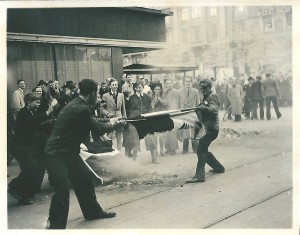 ONCE A COUPLE has made a commitment to stay together and work on their relationship, the next logical step is to help them become allies, not enemies. It’s fruitless to take two people who are angry with each other and try to lead them along a path of spiritual and psychological growth—they would spend too much time trying to knock each other off the road. In order to make the surest and fastest progress toward their relationship vision, they need to become friends and helpmates.
ONCE A COUPLE has made a commitment to stay together and work on their relationship, the next logical step is to help them become allies, not enemies. It’s fruitless to take two people who are angry with each other and try to lead them along a path of spiritual and psychological growth—they would spend too much time trying to knock each other off the road. In order to make the surest and fastest progress toward their relationship vision, they need to become friends and helpmates.
But how is this going to happen? How can couples put an end to their power struggle when they haven’t had the opportunity to resolve their fundamental differences? Love and compassion are supposed to come at the end of the therapeutic process, not at the beginning. In the next few weeks, we will be working on resolving these fundamental differences and “dances of disconnection”, but in the meantime, it really can’t hurt to give your relationship a booster with the exercise suggested below, that doesn’t actually require you to be feeling romantic, even though the action and end-result is often one that mirrors this.
We do this by artificially reconstructing the conditions of romantic love. When two people treat each other the way they did in happier times, they begin to identify each other as a source of pleasure once again, and this makes them more willing to take part in intensive therapy.
INSIGHT AND BEHAVIORAL CHANGE
 YEARS AGO Harville Hendrix, the originator of this exercise, was resistant to the idea of such a direct approach to changing his clients’ behaviour. Coming from a psychoanalytic tradition, he was taught that the goal of a therapist was to help clients remove their emotional blocks. Once they had correctly linked feelings they had about their partners with needs and desires left over from childhood, they were automatically supposed to evolve a more rational, adult style of relating.
YEARS AGO Harville Hendrix, the originator of this exercise, was resistant to the idea of such a direct approach to changing his clients’ behaviour. Coming from a psychoanalytic tradition, he was taught that the goal of a therapist was to help clients remove their emotional blocks. Once they had correctly linked feelings they had about their partners with needs and desires left over from childhood, they were automatically supposed to evolve a more rational, adult style of relating.
This assumption was based on the medical model that, once a physician cures a disease, the patient automatically returns to full health. Since most forms of psychotherapy come from psychoanalysis, which, in turn, has its roots in nineteenth-century medicine, the fact that they rest on a common biological assumption is not surprising. But years of experience with couples convinced him that a medical model is not a useful one for relationship therapy. When a physician cures a disease, the body recovers spontaneously because it relies on genetic programming. Each cell of the body, unless it is damaged or diseased, contains all the information it needs to function normally. But there is no genetic code that governs relationships. Long-term love relationships are a cultural creation imposed on biology. Because people lack a built-in set of social instructions, they can be trapped in unhappy relationships after months or even years of productive therapy. Their emotional blocks may be removed, and they may have insight into the cause of their difficulties, but they have a tendency to still cling to habituated behaviours.
Like many couples therapists, he came to the conclusion that he would have to play an active role in helping couples redesign their relationships. Insight into childhood wounds is a critical element in therapy, but it isn’t enough. People also need to learn how to let go of counterproductive behaviours and replace them with more effective ones. And that’s what we’re going to start doing this week if you’re up for it.
CARING BEHAVIORS
 A BEHAVIORAL APPROACH proved especially useful in restoring a couple’s sense of love and goodwill. In his book, Helping Couples Change: A Social Learning Approach to Marital Therapy, psychologist Richard Stuart presents an exercise for couples that helps them feel more loving toward each other simply by engaging in more loving behaviours.
A BEHAVIORAL APPROACH proved especially useful in restoring a couple’s sense of love and goodwill. In his book, Helping Couples Change: A Social Learning Approach to Marital Therapy, psychologist Richard Stuart presents an exercise for couples that helps them feel more loving toward each other simply by engaging in more loving behaviours.
Called “Caring Days,” the exercise instructs husbands and wives to write down a list of positive, specific ways their partners can please them. For example, a man might write down: “I would like you to massage my shoulders for fifteen minutes while we watch television.” Or “I would like you to bring me breakfast in bed on Sunday morning.” The partners are to grant each other a certain number of these caring behaviours a day, no matter how they feel about each other. Stuart discovered that the exercise generated “significant changes in the details of the couple’s daily interaction during the first seven days of therapy, a very firm foundation upon which to build subsequent suggestions for change.”
To see whether or not this behavioural approach actually worked, Harville decided to try it out on Harriet and Dennis Johnson. He chose the Johnsons because they were as unhappy with each other as any couple in his practice. One of Harriet’s main anxieties was that Dennis was going to leave her. In a desperate effort to hold his interest, she flirted conspicuously with other men. To her dismay, Dennis responded to her flirtatious behaviour the same way he responded to just about everything else she did—with stoic reserve. During one session, he mentioned that he was even trying to adjust to the fact that Harriet might one day have an affair. His quiet heroics exasperated his wife, who was trying everything within her power to penetrate his defenses and get him to be more interested in her. Those rare times when she managed to get him riled up, he would behave in typical isolater fashion and flee the house. Most of their fights ended with Dennis’s zooming off to safety in his Audi sedan.
To lay the groundwork for the exercise, Harville asked Dennis and Harriet to tell me how they had treated each other when they were first in love. As he listened to them, he had the strange feeling that they were talking about two different people. He couldn’t imagine Dennis and Harriet going on long Sunday bike rides together, leaving work to meet each other at the movies, and calling each other on the phone two or three times a day.
“What would happen,” he asked them when he recovered from his amazement, “if you were to go home today and start doing all those things again? What if you were to treat each other the same way you did when you were courting?” They looked at him with puzzled expressions.
“I think I would feel very uncomfortable,” Dennis said after a moment’s reflection. “I don’t like the idea of acting differently from the way I feel. I would feel … dishonest. I don’t have the same feelings toward Harriet that I used to, so why should I treat her as if I did?”
Harriet agreed. “It would feel like we were playacting,” she said. “We may not be happy, but at least we try to be honest with each other.”
When Harville explained that taking part in the experiment might help them over their impasse, they agreed to give it a try, despite their initial objections. He carefully explained the exercise to them. They were to go home, make their lists, and volunteer to give each other three to five of those behaviours a day. The behaviours were to be gifts. They were to view them as an opportunity to pleasure each other, not as a bartering tool. And, most important of all, they weren’t to keep score. They were to focus only on the giving end of the equation. They left the office promising to give the exercise an honest effort.
At the beginning of their next appointment, Dennis reported on the results of the experiment. “I think you’re really on to something, Harville,” he said. “We did what you asked us to do, and today I feel a lot more hopeful about our relationship.”
Harville asked him to say more.
 “Well, the day after our appointment, I found myself driving around town in a black mood,” Dennis volunteered. “I can’t even remember what made me feel so down. Anyway, I decided that it was as good a time as any to do what you asked, so I stopped off at a variety store and bought Harriet some flowers. That was one of the requests on her list. So I gritted my teeth and picked out some daisies, because I remembered she always liked daisies. The shop assistant asked me if I wanted a note card and I said, ‘Why not?’ I remember saying to myself, ‘We’re paying Dr. Hendrix a lot of money to make things better, so I’d better do this all the way.’ When I came home, I signed the card ‘I love you.’” He paused for a moment. “The thing that surprised me, Harville, was that, as I handed Harriet the flowers, I really did care for her.”
“Well, the day after our appointment, I found myself driving around town in a black mood,” Dennis volunteered. “I can’t even remember what made me feel so down. Anyway, I decided that it was as good a time as any to do what you asked, so I stopped off at a variety store and bought Harriet some flowers. That was one of the requests on her list. So I gritted my teeth and picked out some daisies, because I remembered she always liked daisies. The shop assistant asked me if I wanted a note card and I said, ‘Why not?’ I remember saying to myself, ‘We’re paying Dr. Hendrix a lot of money to make things better, so I’d better do this all the way.’ When I came home, I signed the card ‘I love you.’” He paused for a moment. “The thing that surprised me, Harville, was that, as I handed Harriet the flowers, I really did care for her.”
“And when I read the card,” Harriet added, “tears came to my eyes. It’s been so long since he’s told me he loved me.” They went on to describe all the other things that they had done to please each other. She had cooked him a roast with all the trimmings, his favourite meal. He had agreed to curl up together in bed as they fell asleep instead of turning his back to her. She had gotten out her yarn and needles and started knitting him a sweater. As they were recounting these events, there seemed to be remarkably little tension between them. When they left the office, Hendrix noticed that as Dennis helped Harriet on with her coat she smiled and said, “Thank you, honey.” It was a little thing, but it was the kind of pleasurable give-and-take that had been so absent in their relationship.
He asked Dennis and Harriet to continue to give each other caring behaviours, and at each session they reported a gradual improvement in their relationship. They not only were treating each other more kindly, but were also more willing to explore the issues that underlay their discontent. They spent less of their time in his office complaining about each other and more time exploring the childhood issues that were the reasons for their unhappiness in the first place.
Because Stuart’s exercise proved so helpful for Dennis and Harriet, Harville used it as a model for an expanded exercise that he labeled “Reromanticizing” because it effectively restored the conflict-free interactions of romantic love.
I too have introduced the Reromanticizing exercise to my clients, and, almost without exception I have noticed that when couples began artificially to increase the number of times a day that they acted lovingly toward each other, they began to feel safer and more loving. This intensifies the emotional bond between them, and as a result they make more rapid progress in their therapy.
I will explain the details of the Reromanticizing exercise below. The exercise is not designed to resolve your deep-seated conflicts (your dance of disconnection), we will be doing more work on that in our sessions together, but it will re-establish feelings of safety and pleasure and set the stage for increased intimacy.
WHY DOES IT WORK?
 WHY IS THIS simple exercise so effective? The obvious reason is that, through daily repetitions of positive behaviours, your old brain begins to perceive your partner as “someone who nurtures me.”
WHY IS THIS simple exercise so effective? The obvious reason is that, through daily repetitions of positive behaviours, your old brain begins to perceive your partner as “someone who nurtures me.”
Painful memories are overlaid with positive transactions, and your partner is no longer categorized as a bringer of pain and discomfort but as a wellspring of pleasure. This opens the way for intimacy, which is only possible in a context of pleasure and safety.
But there are other, subtler reasons the exercise works so well. One is that it helps people erode the infantile belief that their partners can read their minds. During romantic love, people operate out of the erroneous belief that their partners know exactly what it is that they want. When their partners fail to satisfy their secret desires, they assume that they are deliberately depriving them of pleasure. This makes them want to deprive their partners of pleasure. The Reromanticizing exercise prevents this downward spiral by requiring couples to tell each other exactly what pleases them, decreasing their reliance on mental telepathy.
Another consequence of the exercise is that it defeats the tit-for-tat mentality of the Dance of Disconnection power struggle.
When couples take part in the Reromanticizing exercise, they are instructed to pleasure each other on an independent schedule; they mete out a prescribed number of caring behaviours a day, regardless of the behaviour of their partners.
This replaces the natural tendency to hand out favours on a quid pro quo basis: You do this nice thing for me, and I’ll do that nice thing for you.
 Most relationships are run like a commodities market, with loving behaviours the coin in trade. But this kind of “love” does not sit well with our old repitilian brains (the part of us that can feel very scared, unsafe, and so responds in a fight-flight-freeze way). If John rubs Maya’s shoulders in the hope that she will let him spend the day going fishing, a built-in sensor in Maya’s head goes: “Look out! Price tag attached. There is no reason to feel good about this gift, because I’ll have to pay for it later.” Unconsciously she rejects John’s attentions, because she knows that they were designed for his benefit, not hers. The only kind of love that her old brain will accept is the kind with no strings attached: “I will rub your shoulders because I know that you would like it.” The back rub has to come as a “gift.”
Most relationships are run like a commodities market, with loving behaviours the coin in trade. But this kind of “love” does not sit well with our old repitilian brains (the part of us that can feel very scared, unsafe, and so responds in a fight-flight-freeze way). If John rubs Maya’s shoulders in the hope that she will let him spend the day going fishing, a built-in sensor in Maya’s head goes: “Look out! Price tag attached. There is no reason to feel good about this gift, because I’ll have to pay for it later.” Unconsciously she rejects John’s attentions, because she knows that they were designed for his benefit, not hers. The only kind of love that her old brain will accept is the kind with no strings attached: “I will rub your shoulders because I know that you would like it.” The back rub has to come as a “gift.”
This need to be “gifted” comes straight out of our childhood. When we were infants, love came without price tags. At least for the first few months of our lives, we didn’t have to reciprocate when we were patted or rocked or held or fed. And now, in adulthood, a time-locked part of us still craves this form of love. We want to be loved and cared for without having to do anything in return. When our partners grant us caring behaviours independent of our actions, our need for unconditional love appears to be satisfied.
A third benefit of the exercise is that it helps people see that what pleases them is the product of their unique makeup and life experience and can be very different from what pleases their partners. This reinforces the fact that they are separate people. Often, partners in a relationship cater to their own needs and preferences, not to each other’s. For example, a woman I once worked with went to a great deal of trouble to give her husband a surprise fortieth-birthday party. She invited all his friends, cooked his favorite foods, borrowed a stack of his favourite 1970s records (yes, actual LPs!), and organized lively party games. During the party, her husband acted as if he were enjoying himself, but a few weeks later, in the middle of a counseling session, he got up the courage to tell his wife that he had been secretly miserable. “I’ve never liked having a fuss made about my birthday,” he told her. “You know that. And especially not my fortieth birthday. What I really wanted to do was spend a quiet evening at home with you and the kids. Maybe have a homemade cake and a few presents. You’re the one who likes big noisy parties!”
His wife had taken the Golden Rule, “Do unto others as you would have others do unto you,” a little too literally. She had unwittingly given her husband a party that suited her tastes, not his. The Reromanticizing exercise circumvents this problem by training couples to “Do unto others as they would have you do unto them.” This turns their random caring behaviours into “target” behaviours, behaviours that are designed to satisfy their partners’ unique desires.
When couples regularly give each other these target behaviours, they not only improve the superficial climate of their relationship, they also begin to heal old wounds.
So if this makes sense to you, here’s how to do it…
RE-ESTABLISHING CARING BEHAVIOURS EXERCISE
 Time: Approximately 60 minutes.
Time: Approximately 60 minutes.
Purpose: By sharing specific information about what pleases you and agreeing to pleasure your partner on a regular, consistent basis, you can turn your relationship into a zone of safety.
Comments: You can do steps 1–3 separately if you wish. Do the remaining steps together.
DIRECTIONS:
1. The first step in this process is to identify what your partner is already doing that pleases you. Get out separate sheets of paper and complete this sentence in as many ways as possible, being specific and positive and focusing on items that happen with some regularity:
I feel loved and cared about when you …
Examples:
send me text messages out of the blue sharing something about the day, or checking in with me.
tell me you love me (especially face-to-face, but also in text or phone calls).
butter my toast, with just the right amount of butter you know I like.
kiss me before you leave the house.
tell me important things that happen to you.
sit close to me when we’re watching TV.
listen to me when I’m upset.
check with me first before making plans.
want to make love to me.
compliment me on the way I look.
tell me you think I’m a good at […]
recognise/remember that I’m negatively triggered by certain comments/topics.
make sympathetic and validating comments when I’m complaining about my family.
2. Now recall the romantic stage of your relationship. Are there any caring behaviours that you used to do for each other that you are no longer doing? Once again, take out separate sheets of paper and complete this sentence:
I used to feel loved and cared about when you …
Examples:
wrote me love letters.
brought me flowers.
held my hand as we walked.
whispered sexy things into my ear.
called me up on the phone to say how much you loved me.
cooked me special dinners.
stayed up late talking and making love.
made love more than once a day.
kissed me when you went out the door and hugged me when you came home.
3. Now think about some caring and loving behaviours that you have always wanted but never asked for. These may come from your vision of a perfect mate or from prior experience. (They should not, however, refer to activities that are a present source of conflict.) These may be very private fantasies. Whenever possible, quantify your request.
Complete this sentence: I would like you to …
Examples:
massage me for thirty minutes without stopping.
take a shower with me.
buy me some silver jewelry as a surprise.
go backpacking with me three times each summer.
sleep in the nude.
go out to brunch with me once a month.
read to me.
eat dinner in the summer house.
4. Now combine all three lists and indicate how important each caring behaviour is to you by writing a number from 1 to 5 beside each one. A “1” indicates “very important”; a “5” indicates “not so important.”
5. Exchange lists. Examine your partner’s lists and put an “X” by any items that you are not willing to do at this time. (Make sure that you are willing to do all the ones you have not checked.) Starting tomorrow, do at least two of the caring behaviours each day for the next two months, starting with the ones that are easiest for you to do. Add more items to your list as they occur to you. When your partner does a caring behaviour for you, acknowledge it with an appreciative comment. As you will recall from the introduction above caring behaviours are gifts, not obligations. Do them regardless of how you feel about your partner, and regardless of the number of caring behaviours your partner gives you.
6. If either you or your partner experiences some resistance to this exercise, make a note of the thoughts and feelings behind the resistance, and bring this to therapy to discuss with Steve, but keep on doing the caring behaviours regardless. (See below for some explanations of your resistance.)
RESISTANCE TO ENGAGING IN LOVING BEHAVIOURS FOR OUR PARTNER:
 A certain degree of resistance is to be expected. When a husband and wife have been treating each other like enemies for a while, it’s going to feel strange to start writing love notes again. The exercise is going to feel artificial and contrived (which, of course, it is), and to the old threat-perceiving brain anything that is not routine and habituated feels unnatural. The only way to lessen this automatic resistance is to repeat a new behaviour often enough so that it begins to feel familiar and therefore safe.
A certain degree of resistance is to be expected. When a husband and wife have been treating each other like enemies for a while, it’s going to feel strange to start writing love notes again. The exercise is going to feel artificial and contrived (which, of course, it is), and to the old threat-perceiving brain anything that is not routine and habituated feels unnatural. The only way to lessen this automatic resistance is to repeat a new behaviour often enough so that it begins to feel familiar and therefore safe.
Another form of resistance can come from protective or managerial (trying to keep scary/painful stuff under control) parts of us. If we have developed for example an Angry/Blaming Part, or a Detached Part in response to a feeling of deep hurt or pain or deprivation in our relationships, these parts will reveal themselves at this time in terms of not wanting to “play ball” with regard to this whole “reromanticizing” thing. “Why should I do something nice for someone who has hurt me so much in the past, or is maybe still hurting me now?” they might complain.
At this point, a bit like brushing our teeth, or going to the gym even when we don’t feel like it, the importance of gently asking that resistant part to step aside, just for the 5 minutes it takes to do the behaviour is worth the initial discomfort (it’s quite alright if it reasserts itself after we’ve committed to doing the thing it would rather not do).
The key benefit in doing this, is that we carry out a loving Self-led behaviour, even if we don’t actually feel like it, and curiously, this can actually impart some very real feel-good Self-energy to us as well as feeling good for our partner.
The idea of “faking it till you make it” is often derided, but a lot of good psychological research has shown that even if we’re only 2% committed to something that’s good for us, or someone else, just by doing the action a positive energy is generated which starts to transform the 98% of us that’s resistant into something more at peace with the actions we’re carrying out. Love begets love in other words, both in the doer, and the receiver, even if the loving action is only half-heartedly carried out.
If you don’t believe me, give it a go for the next week and let’s talk more next time we meet.
